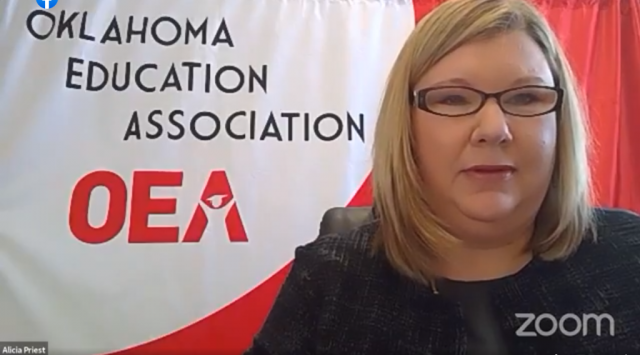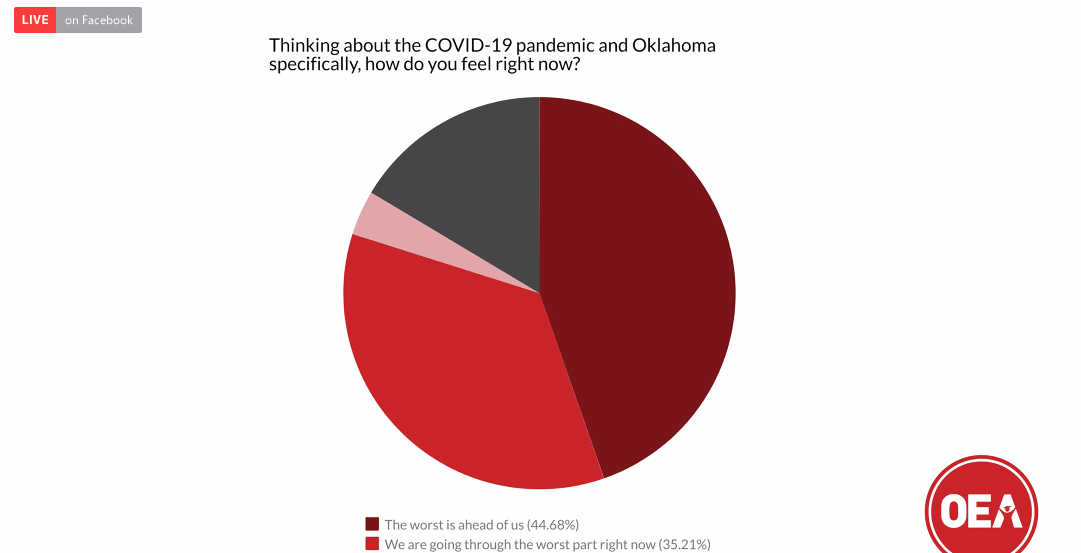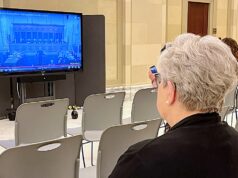

In a recent survey, the Oklahoma Education Association asked more than 3,100 teachers, support professionals and administrators to use one word to describe their current feelings about their job. Words like “stressed,” “overwhelmed,” and “scared” landed in the top 10.
The survey (embedded below) was conducted online Dec. 1 through Dec. 14, and it asked respondents to express their feelings on issues like the pandemic in general, school safety, student learning and how school employees are doing. A total of 3,580 Oklahoma educators completed the survey, with 3,147 responses deemed to be valid. The survey took about 30 minutes to complete and had a 54 percent completion rate, with responses coming from 230 communities.
“As you’ll see in the survey, the number one concern of our members has been the educational progress of our students,” OEA President Alicia Priest said during a Monday press conference announcing the survey results. “However, when the governor released a video last week where blame was placed on OEA and educators for the current state of fear regarding COVID-19 in Oklahoma, or when he declared that all schools must return in-person at an arbitrary date otherwise the state Board of Education could (potentially) supersede local boards, that is not helpful, it is downright hurtful. Parents and educators should not be pitted against one another.”
Issues such as keeping students on track with their education, the mental health and wellbeing of students and keeping students safe and healthy were identified as “major problems.”
The survey also asked Oklahoma educators to rate their stress levels on a scale of 1-10 with a 7.7 average reported.
‘That’s about the same rate as medical professionals on the frontline’

The survey found that about 12 percent of respondents had contracted COVID-19. Priest said about 97 percent of respondents know someone who has contracted COVID.
“That is higher than the general population, and it’s important because what we learned from our OU Health Sciences Center folks is that that’s about the same rate as medical professionals on the frontline,” Priest said.
Many who were surveyed also believe the worst regarding COVID-19 is yet to come. About 45 percent of respondents voted that the worst is ahead of Oklahoma with COVID, with only 4 percent voting that the worst is behind us.
“Educators who have a feel for the community and have a feel for what’s going on in our schools right now really are uncertain about what’s going to happen in the future, even knowing that we have the vaccines that are coming out,” Priest said.
Education professionals were moved up to phase two of vaccine distribution by Gov. Kevin Stitt last week. While there were no questions about the vaccine specifically on the survey, Priest said that at this time there is no mandate for teachers to get the vaccine and that from past discussions there is about a 60/40 split between educators who would get the vaccine when it was available to them and those who don’t want it or want to wait until more studies about the vaccine have been released.
“Even after the vaccinations come out and our educators are getting vaccinated, it’s going to take at least a month and a half to two months for those antibodies to get built up after the second set of shots,” Priest said. “It’s not just about moving us up, it’s moving us up and making sure we have all of the safety protocols put in place to keep our schools open longterm. The only way to do that is if our communities make mitigation of the spread a priority.”
A lack of confidence
Survey results also showed a lack of confidence in elected officials. Only 3 percent of respondents said they are “very confident” that the Stitt administration would provide necessary safety measures for in-person classes, with 82 percent saying they’re not confident.
Only about 17 percent said they were “very confident” that their local district administration will provide what is needed to be safe in schools, with 14 percent voting that they were “very confident” in their local school board.
When Stitt announced that Oklahoma educators would be moved up in vaccine distribution, he also pushed local school boards to return to in-person learning in the spring, suggesting that the state Board of Education could get involved in the process.
“I believe that the state Board of Education has in the past, with their not wanting to pass a statewide mandate for masks and for when schools come in and out, they’ve set a precedent for themselves that they don’t want to make those kinds of statewide mandates,” Priest said. “I think that letting our districts look at the numbers in their areas and make the choices based on their community needs and the community spread is the best choice for us at this time.”
‘I believe it’s absolutely essential that student learning continues to take place’
Asked about the OEA survey, Oklahoma Secretary of Education Ryan Walters said he appreciates feedback from teachers and that he also hears from parents and teachers concerned about the wellbeing of Oklahoma students.
“I believe it’s absolutely essential that student learning continues to take place,” Walters said. “To ensure every student has access to a high quality of instruction, we believe all parents should have an in-person option for their student and that school re-opening should be done in a safe way for teachers and students. This is why we moved teachers to phase two of the vaccination list and work daily with the health department to ensure safe protocols for school re-opening.”
Full OEA survey results
